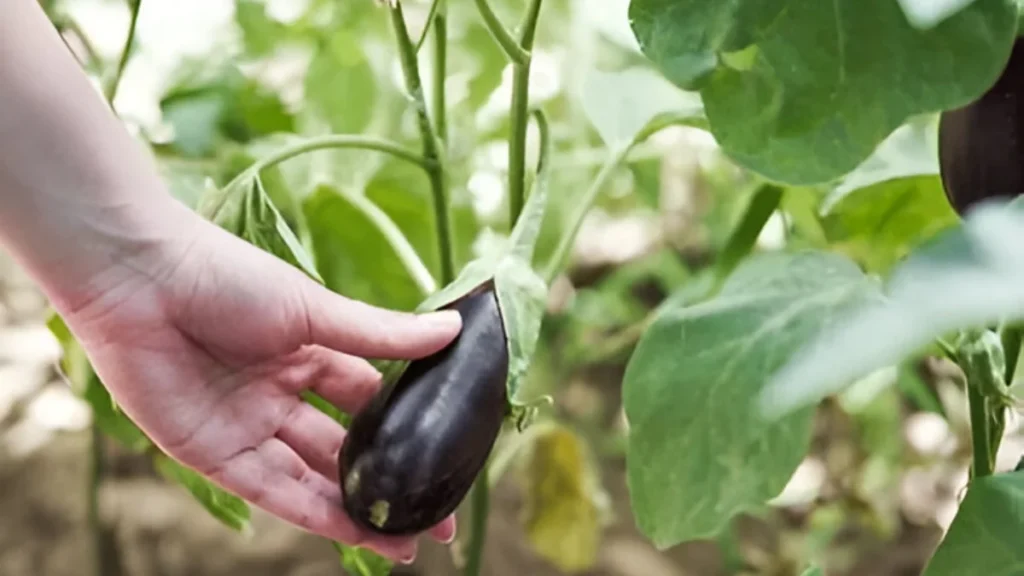In addition to being a novel gardening experience, growing eggplants upside down is a quick, easy, and effective technique to make the most of available space. Without giving up valuable ground space, you can have an abundant crop by hanging your eggplants upside down. This article will walk you through the simple process of growing inverted eggplants and experiencing the delight of a bountiful crop. Eggplants grow very well in pots, which makes them a perfect complement to your balcony garden.
The Advantages of Growing Eggplants Horizontally:
- Inverted gardening is ideal for urban environments as it effectively utilizes vertical space. Those living in apartments or with limited ground space would benefit from this.
- Increased air circulation around the leaves and fruit is made possible by hanging the plants. This can lower the chance of fungal infections, which are prevalent in moist, stagnant places.
- Growing eggplants off the ground helps them stay healthier and more robust by limiting their exposure to pests and diseases carried by the soil.
- By doing away with the need to stake or support plants, this technique eases care and lessens physical strain on the plants.
- Weeding is almost nonexistent because the plants are not in the ground, and soil care is greatly decreased.
- Watering from above guarantees that nutrients and water reach the roots directly, which is critical for eggplant growth.
- When combined with their functionality and aesthetic appeal, upside-down eggplants provide an intriguing visual addition to any garden area.
The Process: Growing Eggplants Upside Down
This is thorough advice on how to put up an eggplant garden that is upside down:
Supplies Needed:
- adopted plastic bottles (2 liters or more; larger volumes are advised)
- Plantain seedlings
- Tape for masking
- Punch a hole
- The silverware
- healthy twine
- superior compost or soil
Methodical Guide:
- Pick a location that gets at least 6 to 8 hours of sunlight per day. Eggplants prefer warm, sunny weather.
- Take off the labels and clean the plastic bottles. Cleanly chop off the bottle’s bottom with a knife.
- To prevent sharp edges, hide the cut edge using masking tape. Next, make four holes for the twine, spaced evenly around the bottle.
- Take the baby eggplants out of their nursery pots and carefully transfer them to the container. Make sure the root ball is completely covered when you plant it in the center.
- Leaving a little space at the top for watering, fill the bottle with soil or compost.
- Use sturdy hooks or a dependable hanging method to safely suspend the container. Verify that it is sturdy and able to support the weight of the developing plants.
- Make sure the soil around your hanging eggplant plants is continuously moist but not soggy by checking them frequently.

Growing eggplants upside down offers several benefits, including space efficiency, reduced pests and diseases, improved air circulation, less weeding and maintenance, and enhanced fruit production. It's ideal for small gardens, balconies, and patios, and helps prevent soil-borne pests and diseases. Additionally, it ensures optimal solar exposure for optimal fruit production.
Conclusion:
Anyone can enjoy this fun and space-saving gardening method of growing eggplants upside down. Uniquely and enjoyably, you can soon be harvesting delicious eggplants with the necessary supplies and a little attention.
A frequently asked questions:
Q1. Can I use any type of container for growing eggplants upside down?
A1: In Minecraft, you can plant pumpkin seeds by tilling a portion of farmland and then placing the seeds on the tilled soil. Make sure the space is hydrated and well-lit.
Q2. What are the growing eggplant problems?
A2. Typical concerns include fungi, pests like flea beetles and aphids, poor fruit set from poor pollination, and yellowing leaves from overwatering or nutrient shortages.
Q3: What is the best time to start growing eggplants from seeds indoors?
A3: Six to eight weeks before the final anticipated date of frost in your area, start eggplant seeds indoors. This enables the healthy development of seedlings prior to their outside transplantation.
Q4: What type of soil should I use for growing eggplants in pots?
A4: Use well-drained, nutrient-rich soil mixed with loamy garden soil, compost, and perlite or sand to improve aeration. Healthy eggplant growth in pots requires a pH range of 5.5 to 6.5.
Q5: How many eggplants can you get from one plant?
A5: A robust eggplant plant may yield between 5 and 12 eggplants every season, depending on the type, growth circumstances, and maintenance. Regular picking promotes increased fruit output.



